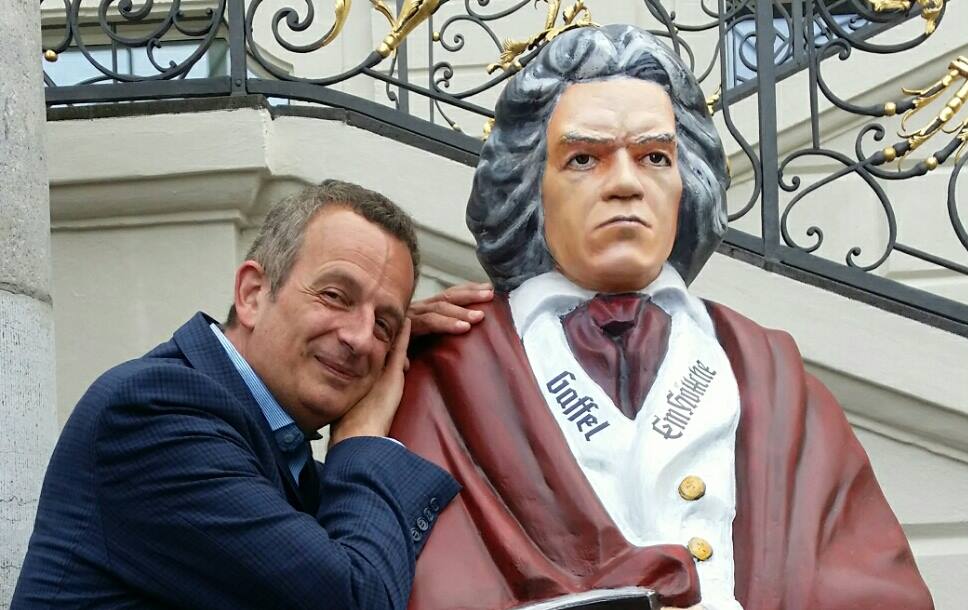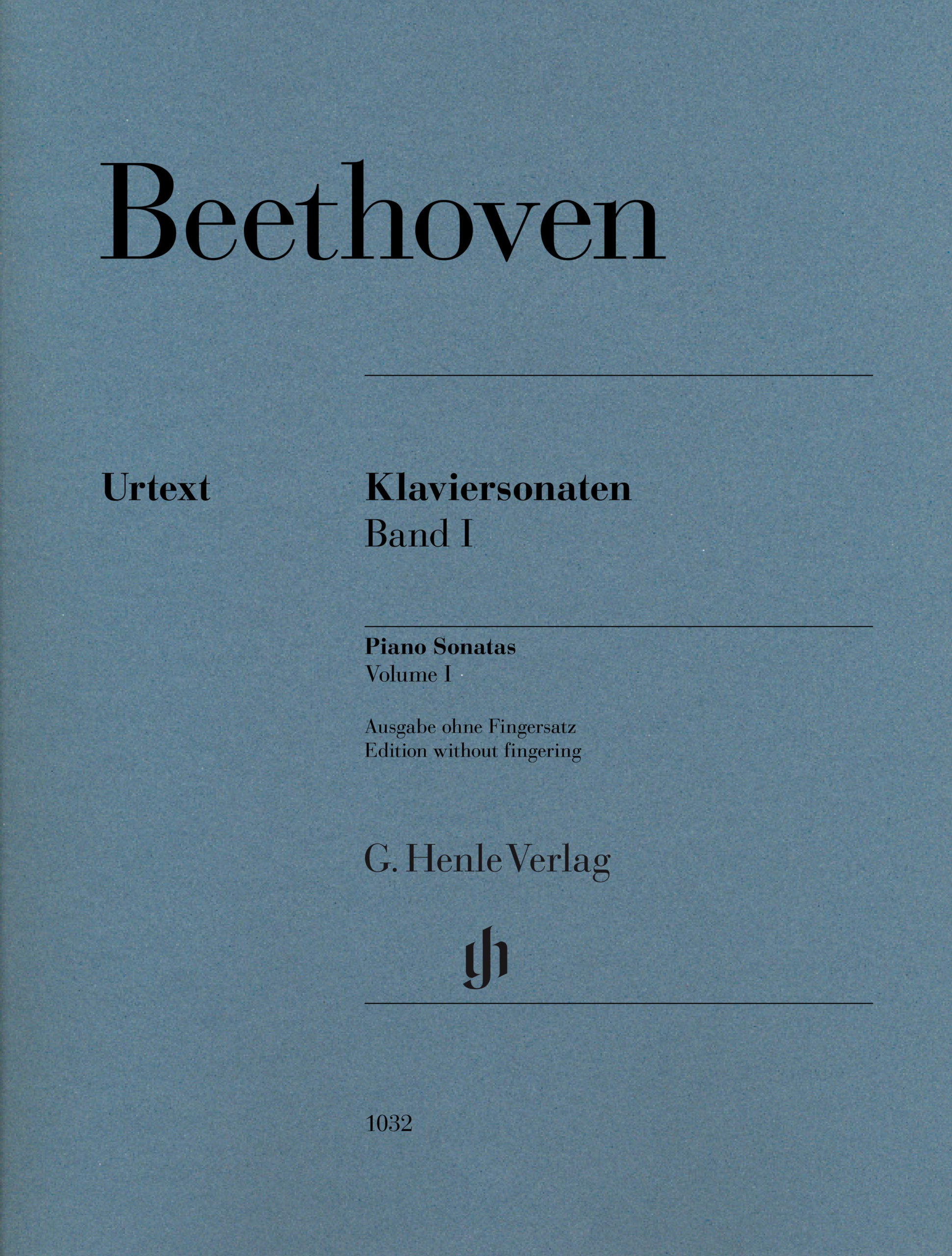From time to time during the Beethoven year the team of Henle blog posters would like to interview artists who have made a special contribution to Beethoven’s work and are also closely affiliated with the Henle publishing house and its Urtext editions. We are starting with Michael Korstick who recorded Beethoven’s piano works in 11 instalments for Oehms Classic in 1997–2008, including all 32 piano sonatas, the great variation sets opp. 34, 35, 120, the late bagatelles op. 126, together with the ‘Wut über den verlorenen Groschen [Rage over the lost penny]’. A truly impressive recording compendium that set new standards of interpreting Beethoven.
Norbert Müllemann (NM): Dear Mr Korstick, we are still at the start of the Beethoven Jubilee Year – are you anticipating the next 11 months with joy or with horror?

left to right: Dr Wolf-Dieter Seiffert (Managing Director G. Henle Verlag), Michael Korstick, Dr Norbert Müllemann (Editor-in-Chief G. Henle Verlag)
Michael Korstick (MK): A good question … the answer is probably somewhere in-between. Of course, we can’t hear enough Beethoven, that much is certain. Only I fear that instead of a worthwhile anniversary celebration, a marketing orgy will befall us, bringing with it a lot of superfluous and annoying things. I don’t like to think about how many new recordings are being marketed, which the world doesn’t need, offering zero insight. On the other hand, I see this as an opportunity, that the enormous media impact of this anniversary may possibly enable many people initially to come in contact with this great music, such an opportunity as would not have otherwise existed. I personally had planned not to play Beethoven at all in 2020 out of a spirit of contrariness and pure stubbornness, though (unfortunately?) I could not hold out there.
NM: That’s if anything, good news, of course, for us consumers! What does Beethoven mean to you and how important is his music in your repertoire?
MK: From the outset Beethoven was the fixed star of my musical universe. I can still well remember what the first encounters with every single work triggered in me as a very young guy. To call this earth-shaking would be a flat understatement! To this day, dealing with Beethoven’s works has remained for me a crucial concern.
 NM: I think we can tell this from your playing! The critics were indeed very enthusiastic about your great Beethoven project at Oehms. We feel like we’re hearing a “new” Beethoven tone, and yet it is always one that necessarily results logically from the music itself. Were you guided by a basic concept in your recording? Did you have a goal in mind as to how you wanted to present Beethoven to us?
NM: I think we can tell this from your playing! The critics were indeed very enthusiastic about your great Beethoven project at Oehms. We feel like we’re hearing a “new” Beethoven tone, and yet it is always one that necessarily results logically from the music itself. Were you guided by a basic concept in your recording? Did you have a goal in mind as to how you wanted to present Beethoven to us?
MK: That’s extremely difficult to answer. And any attempt at an answer opens the door to serious misunderstandings. For example, after several interviews about it, my strategy was reduced, almost single-dimensionally, to addressing the aspect of so-called fidelity to the work. Through my own source research, I did, of course, try to approach as closely as possible the sense of what Beethoven meant, but in the end it can’t and shouldn’t be simply a matter of referencing something identified as correct, so to speak, but the result of such efforts must be to recognise what is “right”, to feel it and then to transform it creatively into sound. To paraphrase Beethoven’s dictum, the performer must recognise what comes from the composer’s heart before he uses his lifeblood to touch the listener’s heart. Then, there is no room for arbitrariness or blethering sensitivities!
NM: G. Henle Verlag is very pleased that you are currently working on fingering Beethoven’s 32 piano sonatas for our Henle Library app. What are the particular challenges in developing a Beethoven fingering? Will it be specifically tailored to Michael Korstick, or do you have a pedagogical approach to fingering that is easy for the average pianist to assimilate?
MK: This project is particularly exciting for me because it uses a new medium that radically changes the fingering requirements for a classic printed edition, if only because in the app the user can choose from several fingerings for the same piece. Conrad Hansen’s fingering for B. A. Wallner’s iconic Henle edition has successfully achieved what I would call the squaring of the circle, and I’m not saying that because I was a second-generation pupil of Hansen’s through my first teacher Jürgen Troester. Here is a fingering, successfully tried out by Hansen in practice, that complies on the one hand with the classical rules, and is suitable on the other for a large number of different hands. The pioneering Henle app, though, now enables me to make my personal solutions accessible, one-on-one, to interested pianists without my having to be concerned about its pedagogical suitability. That’s why I see my personal fingerings as nothing more than merely a source of information for fellow pianists wanting to know which solutions I myself use, and who can then check my recordings to hear how the sound is thereby implemented.
NM: Let’s get to the music text itself, whether on an app or in print: How important is it to you to play Beethoven from an Urtext edition (ideally from Henle…)? Does a correct Urtext without any instructive indications still provide enough suggestions for interpretation?
MK: For Beethoven there is no alternative to the Urtext! He was the first composer to leave precise, almost overly precise, performance indications, because to him it was important to specify every expressive detail for the player. Those of the Mozart generation still assumed that their works would be played by either the respective composer’s direct students or by fellow composers who would already know what was intended. Beethoven, on the other hand, was an innovator and individualist who precisely specified his personal and revolutionary style as if anticipating that his works would someday fall into the hands of “touring virtuosos”. I myself got to know the Beethoven sonatas from the Bülow edition, brought back by my father who was interned in the United States during the Second World War. When I won 1st prize in the “Jugend musiziert” [Youth Makes Music] competition in Cologne at age 11, the prize I received was a music voucher of 200 marks which I used for the purchase of the Henle editions of Bach’s well-tempered clavier, the Mozart sonatas and the Beethoven sonatas. This completely changed my musical world view! So-called instructive indications such as are included in the Bülow or Schnabel Beethoven editions may be interesting or even inspiring, but they cannot replace or even improve on what the composer specifies. Only exact adherence to the Urtext editions can be a prerequisite for a personal interpretation of the musical text. Since it is already difficult enough to implement meaningfully all the composer’s individual performance instruction, no one needs additional or even modifying annotations.
NM: If you look at all the Beethoven piano works, is there one that offers outstanding or particularly difficult textual problems, where an Urtext edition is vital for providing the necessary information for the performer?
 MK: Urtext editions are basically indispensable! And publishers have a standing responsibility here to continue research and to revise any possible editorial errors. A wonderful example: whilst preparing for my CD recording of the Diabelli variations in 2004, I found a mistake in the 10th variation during my studies in the Bonn Beethoven-Haus archives, which had led to different readings of a chord in all the editions available at the time, none of them correct. On the CD I played my own solution. I found this error corrected just so in the new Henle edition, which filled me with a veritable personal satisfaction. It isn’t signficant, of course, which notes you play but how you play them – though if artistic inspiration is combined with optimal textual accuracy, then perhaps the best of both worlds can really be achieved.
MK: Urtext editions are basically indispensable! And publishers have a standing responsibility here to continue research and to revise any possible editorial errors. A wonderful example: whilst preparing for my CD recording of the Diabelli variations in 2004, I found a mistake in the 10th variation during my studies in the Bonn Beethoven-Haus archives, which had led to different readings of a chord in all the editions available at the time, none of them correct. On the CD I played my own solution. I found this error corrected just so in the new Henle edition, which filled me with a veritable personal satisfaction. It isn’t signficant, of course, which notes you play but how you play them – though if artistic inspiration is combined with optimal textual accuracy, then perhaps the best of both worlds can really be achieved.
NM: A fine closing word! Dear Mr Korstick, thank you for this interview. We are very much looking forward to your fingering in the app and wish you the very best for your projects in the Beethoven Year!


